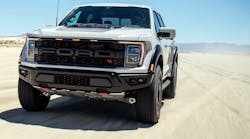Ford’s Farley Pounds Table on Streamlining After Strong Q2
Ford Motor Co. grew wholesale shipments more than a third year over year and produced nearly $3 billion in operating cash flow in the second quarter, setting the stage for a dividend increase that has lifted the company’s stock. But on a conference call with analysts after reporting those numbers, CEO Jim Farley returned to a familiar theme: The storied company’s transformation is in its very early stages.
“In the past, at least in my career for 40 years, we have often discriminately just taken costs out. That's not what's happening at Ford now,” Farley said. “This is a different kind of change where we're reshaping the company, reshaping skills, investing in new technologies and simplifying investments in others, i.e., spending less.”
Asked if that means Ford has too many people Farley said yes but quickly added that it’s mostly about having people in the wrong places given Ford’s growth plans and prospects. (Bloomberg reported last week the company plans to cut 8,000 people from its internal combustion business but Farley said his team will detail plans on its own schedule.) Investments are being focused on the electric vehicle market—the company last week announced some big agreements to secure its raw materials supplies—and that means the legacy ICE business, recently renamed Ford Blue, has a lot of work to do further fund the EV push.
“We have to bring our complexity down to get our bill of materials in line with competition. It's great that we have all this pricing power forward. We do have a fresh lineup. We have lots of cool ideas,” Farley said. “But we're not satisfied with that because we cannot just continue to build this complexity in our business. That is a theme that will run through Blue for years to come.”
Adjusted for one-time items, Ford’s second-quarter net income of $667 million on sales of $37.9 billion–adjusted earnings before interest and taxes more than tripled to $3.7 billion and its EBIT margin topped 9%–handily beat analysts’ estimates. Farley and CFO John Lawler affirmed their full-year forecasts for earnings and free cash flow, with Lawler adding that volumes will be a little lower than Q2 in the third quarter but should rebound late this year thanks in part to better semiconductor availability.
Inflation continues to bite into Ford’s operations, though, as it has been affecting other companies. Farley and Lawler have ballparked the 2022 impact of higher commodity prices at $4 billion and now say that other inflationary factors will cost the company $3 billion more than in 2021, which is an increase of $1 billion from their previous forecast. In response, Lawler said the company is looking to cut costs by $3 billion in coming years.
Other notes from Ford’s earnings results and call:
- The company took a $2.4 billion write-down on its investment in EV truck maker Rivian Automotive Inc., adding to a paper loss of more than $5 billion it took in Q1. During the quarter, Ford sold more than 25 million of its roughly 100 million Rivian shares for about $700 million.
- Ford’s board of directors has approved an increase in the company’s quarterly dividend to 15 cents per share. That restores the quarterly payout to its pre-pandemic level.
- Lawler said consumer demand has not yet fallen off in the face of inflation and other economic headwinds, including higher pricing for Ford’s products. But, he added, buyer incentives have been very low and the company has built into its assumptions a greater use of them in the second half of 2022 to keep vehicles moving off dealer lots as inventories grow.
Boosted by the Q2 numbers and the dividend news, shares of Ford (Ticker: F) rose nearly 5% in early trading July 28 on high volume. Year to date, however, they have lost more than a third of their value, shrinking the company’s market capitalization to about $54 billion.




